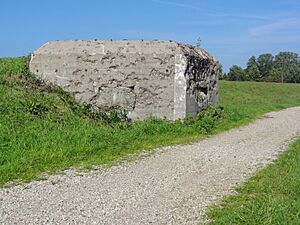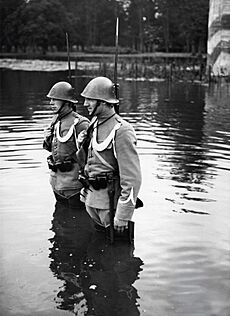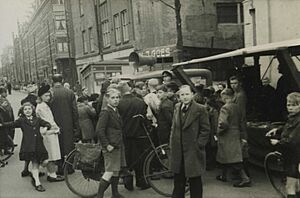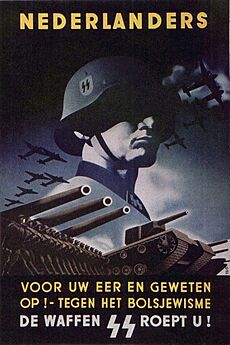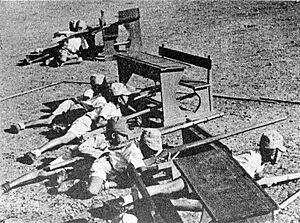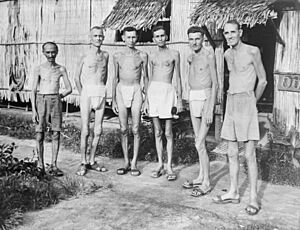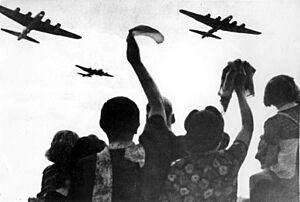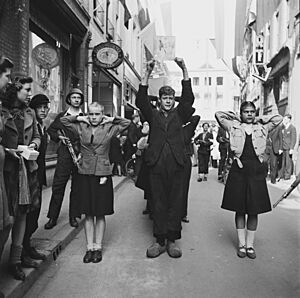Netherlands in World War II facts for kids
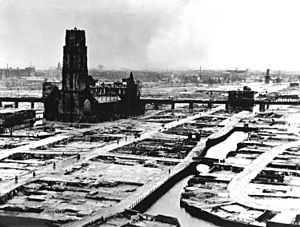
Even though the Netherlands wanted to stay neutral, Nazi Germany invaded the country on May 10, 1940. This was part of Germany's plan called "Fall Gelb." Just one day after the terrible bombing of Rotterdam, Dutch forces gave up. The Dutch government and the royal family moved to London for safety. Princess Juliana and her children found a safe home in Ottawa, Canada, until the war ended.
German rule lasted in some parts of the Netherlands until May 1945. At first, only a few people joined the resistance movement. But it grew bigger as the occupation continued. The Germans sent most of the country's Jewish people to Nazi concentration camps. About 70% of Jewish people in the Netherlands were killed during World War II. This was a much higher number than in Belgium or France.
The war in the Netherlands happened in four main parts:
- September 1939 to May 1940: The Netherlands declared neutrality when the war started. But then, Germany invaded and took over.
- May 1940 to June 1941: Germany's orders helped the Dutch economy. The German leader, Arthur Seyss-Inquart, was quite gentle at first. This made the occupation seem mild.
- June 1941 to June 1944: As the war got tougher, Germany demanded more from occupied lands. This made life harder for people. Attacks on Jewish people became much worse, and thousands were sent away. The "gentle" approach ended.
- June 1944 to May 1945: Conditions got even worse. There was not enough food or fuel. German leaders slowly lost control. Some Nazis wanted to destroy things, while others tried to help.
The Allied forces freed most of the southern Netherlands in late 1944. But the rest of the country, especially the west and north, stayed under German control. They suffered from a terrible lack of food in late 1944. This time is known as the "Hunger Winter." On May 5, 1945, Germany surrendered, and the whole country was finally free.
Contents
Life Before the War
The Netherlands was one of Europe's richest countries before World War II. It had colonies like the Dutch East Indies (now Indonesia). These colonies made the Netherlands one of the world's top oil producers. The country also had a very large aircraft factory (Fokker). This helped the Netherlands stay neutral and sell weapons during the First World War.
From 1933, the Netherlands was hit by the Great Depression. This was a time when many people lost their jobs and money. The government tried to keep its money (the guilder) strong. This led to protests and even a naval mutiny. Eventually, in 1936, the government had to let its money lose value.
During this time, some groups like the National Socialist Movement in the Netherlands (NSB) appeared. They were inspired by Italian fascism or German Nazism. But these groups never became very popular in the Netherlands. People did not like their ideas about race or violence. By the time World War II started, the NSB was losing members.
The government also built many new roads and reclaimed land from the sea. One big project was the Zuiderzee Works. This included draining the Wieringermeer polder and finishing the Afsluitdijk dam.
Staying Neutral
During World War I, the Dutch government managed to stay neutral. After that war, the Netherlands continued its "Independence Policy." Even when the Nazi Party came to power in Germany in 1933, the Dutch believed they could avoid war.
The prime minister, Hendrikus Colijn, thought the Netherlands could not fight a major power. So, the government did not spend much on its military. Even though military spending doubled between 1938 and 1939, it was still very low compared to Germany. The Dutch government hoped its neutrality, or help from other countries, would protect it.
However, the government did start planning defenses. This included the "New Dutch Waterline." This was an area east of Amsterdam that could be flooded to stop invaders. From 1939, they also built strong defenses like the Grebbe and Peel-Raam Lines. These protected important cities like Dordrecht, Utrecht, Haarlem, and Amsterdam. This area was called Vesting Holland (or "Fortress Holland").
In late 1939, Germany promised to respect Dutch neutrality. The Dutch military slowly got ready for war. By April 1940, it was at full strength.
German Invasion
Despite its neutrality, Germany invaded the Netherlands on the morning of May 10, 1940. There was no formal declaration of war. German forces also moved into Belgium and Luxembourg at the same time. Germany wanted to draw Allied forces away from other areas. They also needed to take over Dutch airfields on the North Sea to attack the United Kingdom.
The armed forces of the Netherlands were not ready. Their weapons and equipment were old. The Royal Netherlands Army had very few tanks. The air force had only 140 planes, mostly old biplanes. Sixty-five Dutch planes were destroyed on the first day.
The German forces moved quickly. But they faced strong resistance. On the first day, German paratroopers tried to capture the Dutch government in The Hague. They also tried to take key airfields. But Dutch ground forces fought them off, causing many German losses. The Dutch even destroyed many German transport planes. These planes were needed for Germany's planned invasion of Britain.
However, German forces managed to cross the Maas River. This allowed them to get around Belgian defenses. In the eastern Netherlands, the Germans pushed the Dutch back from the Grebbe Line. But their advance was slowed by Dutch forts on the Afsluitdijk Causeway. By the fourth day, Germany controlled most of the eastern country.
The Dutch realized that British or French troops could not arrive fast enough to stop the invasion.
Bombing of Rotterdam
Fighting had been happening in Rotterdam since the first day. German soldiers landed on the Maas River in seaplanes and captured bridges. The Germans did not want to risk a tank attack on the city. Instead, the German commander gave an ultimatum to the Dutch commander. He demanded the Dutch soldiers surrender. If they did not, he threatened to destroy the city with bombs.
The ultimatum was sent back because it was not signed. While a corrected one was being sent, German bombers attacked the city. They did not know that talks were still happening.
During the Rotterdam Blitz, between 800 and 900 Dutch civilians were killed. About 25,000 homes were destroyed. The bombers aimed at civilian areas, not the city's defenses. The Dutch commander in Rotterdam surrendered the city and his 10,000 men. This happened on the evening of May 14, with permission from Henri Winkelman, the Dutch commander-in-chief. This opened the way for the Germans to advance into "Fortress Holland."
Dutch Surrender
The Dutch military leaders were shocked by the Rotterdam bombing. They knew the army was running low on supplies. They also heard that Utrecht had received a similar threat. General Winkelman met with other generals. They decided that fighting more was useless. They wanted to protect civilians. On the afternoon of May 14, Winkelman ordered his army to surrender.
He said that Germany had bombed Rotterdam and threatened Utrecht. To save civilians and stop more bloodshed, he ordered troops to stop fighting. He explained that the enemy had broken their resistance with much stronger and more modern weapons. He added that the Dutch had nothing to be ashamed of.
On May 15, the Netherlands officially surrendered to Germany. Dutch forces in Zeeland province kept fighting with French forces until May 17. The bombing of Middelburg forced them to surrender too. The Dutch Empire, especially the Dutch East Indies, supported the Allies. The colonies were not affected by the surrender. Many ships of the Royal Dutch Navy sailed to the United Kingdom.
During the four-day invasion, about 2,300 Dutch soldiers were killed and 7,000 wounded. More than 3,000 Dutch civilians also died. The Germans lost 2,200 men killed and 7,000 wounded. Also, 1,300 German soldiers captured by the Dutch were sent to Britain. They stayed as prisoners of war for the rest of the war.
Queen Wilhelmina and the Dutch government escaped before the surrender. They formed a government-in-exile in London. Princess Juliana and her children went to Canada for safety.
German Occupation
Life Under German Rule
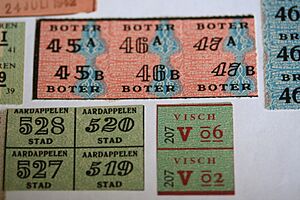
At first, the Netherlands was under German military control. But the Dutch government refused to return. So, on May 29, 1940, a German civilian governor took control. This was different from France or Denmark, which had their own governments. The new German government, called the Reichskommissariat Niederlande, was led by Arthur Seyss-Inquart.
The Germans started a policy called Gleichschaltung. This meant "forced conformity." They slowly removed all groups that were not Nazi. In 1940, they banned all socialist and communist parties. In 1941, they banned all parties except for the National Socialist Movement in the Netherlands.
This was a big shock for the Dutch. They had always had separate groups for different religious beliefs, especially Catholic and Protestant. The Catholic Church in the Netherlands opposed this. In 1941, Dutch bishops told all Roman Catholics to leave groups that had become Nazi.
The Nazis wanted to make the Netherlands part of a larger German empire. Adolf Hitler thought highly of the Dutch people. He saw them as part of the "master race."
At first, Seyss-Inquart used a "velvet glove" approach. He tried to be gentle to win over the Dutch people to Nazi ideas. This meant less harsh treatment and less taking of goods. He also tried to work with Dutch leaders. The German market opened up, and Dutch companies benefited from selling goods to Germany. Many people thought Germany might win the war. So, it seemed smart to cooperate. The NSB grew quickly.
After Germany's failures in Russia in 1941, they demanded more from occupied lands. This included the Netherlands. They took more goods, and production focused only on war efforts. Treatment became harsher, especially against Jewish people.
After the Allied invasion in June 1944, a railway strike and the war front cut off food and fuel to the western Netherlands. This led to severe hunger, known as the Hongerwinter. German authorities lost control. People tried to hide their belongings from German seizures. They were less willing to cooperate because it was clear Germany would lose. Some Nazis wanted to destroy things, but others tried to help.
Air Force Bases
The German air force, the Luftwaffe, was very interested in the Netherlands. They wanted to build many air bases there to attack the United Kingdom. They started building ten large military air bases the day after the Dutch surrendered. Each base had runways, railway connections, repair shops, and housing for thousands of soldiers. The largest was Deelen Air Base.
Within a year, the air war changed to defense. Over the Netherlands, almost 20,000 airmen (Allied and German) died. About 6,000 planes crashed there during the war. The Netherlands became Germany's first line of air defense. It had many anti-aircraft guns and radar systems. The first German night-hunter squadron started operations from the Netherlands.
Forced Labor and Resistance
The Germans forced Dutch civilians to work for them. This was called Arbeitseinsatz. Every man between 18 and 45 (about 530,000) had to work in German factories. These factories were often bombed by the Allies. Those who refused had to go into hiding. As food and goods were taken from the Netherlands, rationing increased. The resistance sometimes raided distribution centers to get ration cards for people in hiding.
To succeed, resistance members sometimes had to pretend to work with the Germans. After the war, this caused problems for them if they could not prove they were in the resistance.
Atlantic Wall Defenses
The Atlantic Wall was a huge coastal defense line built by the Germans. It stretched along the European coast. The Dutch coastline was part of it. Some towns, like Scheveningen, were emptied because of this. In The Hague alone, thousands of houses were destroyed. About 65,000 people were forced to move. The Dutch were also forced to work on these projects. But they often worked slowly or poorly as a form of passive resistance.
The Holocaust in the Netherlands
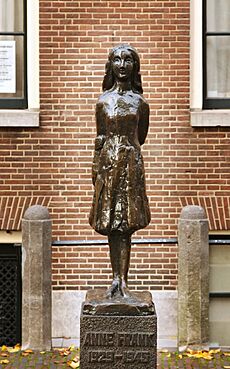
Soon after the Germans took over, they began to persecute Jewish people in the Netherlands. In 1940, only small steps were taken. But in February 1941, the Nazis sent a small group of Dutch Jews to a concentration camp. The Dutch reacted with the February strike. This was a nationwide protest against the deportations. It was unique in Nazi-occupied Europe. Even though the strike leaders were executed, it was a setback for Seyss-Inquart. He wanted to deport Jews and win over the Dutch.
Before the strike, the Nazis set up a Jewish Council. This was a group of Jewish leaders. The council was used to help identify and deport Jews more easily. The Jewish leaders on the council were told they were helping their people.
In 1939, about 140,000 to 150,000 Jewish people lived in the Netherlands. Many were refugees from Germany. The Westerbork transit camp was set up for refugees. In 1942, the Germans used it to send Jews to labor and concentration camps. Over half of all Jewish people in the Netherlands lived in Amsterdam. This number grew as Germans forced Dutch Jews into the city for mass deportations.
In May 1942, Jews were ordered to wear Star of David badges. The Catholic Church in the Netherlands spoke out against this. Later, Catholic priests were sent to concentration camps.
Concentration camps were also built at Vught and Amersfoort. With help from Dutch police, most Dutch Jews were sent to concentration camps.
Germany was very effective at deporting and killing Jews in the Netherlands. By 1945, only about a quarter of the Jewish population remained (about 35,000). About 8,500 avoided deportation by being in a mixed marriage. About 16,500 hid. And 7,000-8,000 escaped the Netherlands.
The survival rate for Jews in the Netherlands was 27%. This was much lower than in Belgium (60%) or France (75%). Historians have different ideas why. Some say the Netherlands had religion in its national records, making it harder for Jews to hide their identity. Others say Dutch officials cooperated more. The flat landscape also offered fewer hiding places.
New records showed that Germans paid money to Dutch police and officials. This was a reward for finding and identifying Jews.
Collaboration with Germans
Many Dutch people chose or were forced to work with the German regime. Some joined the German armed forces, like the Waffen-SS. Others, like members of the Henneicke Column, actively helped capture hiding Jews for money. It is thought that this group captured about 8,000 to 9,000 Dutch Jews who were later killed.
The National Socialist Movement in the Netherlands (NSB) was the only legal political party from 1941. It worked closely with the Germans. In 1941, when Germany seemed sure to win, about 3% of adult Dutch men were in the NSB.
When the war started, the NSB supported Germany but wanted the Netherlands to stay neutral. After the German invasion in May 1940, the Dutch government arrested 10,000 NSB members. But German troops freed them after the Dutch defeat. In June 1940, NSB leader Anton Mussert told the Dutch to accept the Germans and reject the Dutch Royal Family, who had fled to London.
The NSB's membership grew to about 100,000. Many new members joined, some just to gain advantages. The NSB played a role in local government. Every new mayor appointed by the Germans was an NSB member. But for higher positions, the Germans often kept existing Dutch leaders.
After Germany surrendered on May 6, 1945, the NSB was banned. Mussert was arrested and executed in 1946. Many NSB members were arrested, but few were punished severely.
Between 22,000 and 25,000 Dutch men volunteered to serve in the Waffen-SS. They fought mainly on the Eastern Front.
Dutch companies also helped the German war effort by providing goods and services. Especially in 1940 and 1941, when a German victory seemed possible, Dutch companies were willing to sell to the Germans. After the war, few high officials or company directors faced harsh sentences for this.
Dutch Resistance
The Dutch resistance against the Nazis grew slowly. But its spy networks and sabotage helped Allied forces from 1944. If the Germans found out someone was in the resistance, it meant an immediate death sentence.
The Netherlands' flat land and dense population made it hard to hide illegal activities. There was no easy escape route except by sea. Resistance groups were small and worked independently. The Communist Party of the Netherlands organized resistance from the start. Other groups, like the LKP (National Force Units), also helped. The LKP was one of the largest groups. They were targeted by the Nazis because they had links to the Dutch government in London.
These groups made fake ration cards and money. They gathered information, published secret newspapers, cut phone lines, and distributed food. After 1942, larger groups started working together. Some contact was made with the government in London. After D-Day, the main resistance groups joined forces.
One of the most dangerous activities was hiding people. This included Jewish families, resistance workers, and young Dutch men avoiding forced labor. These people were called onderduikers ('under-divers'). Later, this system also protected Allied airmen whose planes had been shot down.
In February 1943, a Dutch resistance group shot Hendrik Seyffardt. He was a Dutch general who helped recruit volunteers for the German army. His death led to harsh revenge. The Germans killed 50 Dutch hostages and raided Dutch universities. In October 1944, the resistance attacked German troops near Putten. This led to terrible war crimes. Part of the town was destroyed, and seven people were shot. Most of the men from Putten were sent to forced labor camps. Only 48 out of 552 survived.
On March 6, 1945, the Dutch resistance attacked a German car. They did not know it carried a high-ranking SS general. This led to the killing of 116 men at the ambush site and 147 other prisoners.
Dutch Government and Army in Exile
The Dutch army's strong fight in The Hague allowed the royal family to escape. Days before the surrender, Princess Juliana, Prince Bernhard, and their daughters went to London. On May 13, Queen Wilhelmina and key government members followed. Princess Juliana later took her children to Canada for safety.
After Germany won, they invited the Dutch government to return and form a pro-German government. Prime Minister Dirk Jan de Geer wanted to accept. But the Queen refused and replaced him with Pieter Gerbrandy.
War in the Far East
On December 8, 1941, the Netherlands declared war on Japan. On January 10, 1942, Japan invaded the Dutch East Indies (now Indonesia).
Dutch naval ships joined Allied forces to form the ABDA Fleet. This fleet was led by Dutch Rear Admiral Karel Doorman. On February 27-28, 1942, Doorman was ordered to attack the Japanese navy. His fleet suffered heavy losses in the Battle of the Java Sea. Many Dutch ships were lost.
After Japanese troops landed on Java, Dutch forces there surrendered on March 7, 1942. About 42,000 Dutch soldiers were taken prisoner. Many were forced to work in labor camps. Later, about 100,000 Dutch civilians were also arrested and put in camps. Some were sent to Japan or forced to work on the Thai-Burma Railway.
Dutch submarines escaped and continued fighting with the Allies from Australia. They hunted Japanese tankers and troop movements. Because many Dutch submarines were active, the Dutch were called the "Fourth Ally" in the Pacific.
Many Dutch airmen also escaped. With planes from the Americans, they formed two squadrons. These squadrons flew bombing raids from Australia to the Dutch East Indies. They also helped recapture the islands.
Control of the Dutch East Indies was slowly taken back from Japan. The largest Allied invasion in the Pacific happened in July 1945. Australian forces landed on Borneo to take oil fields from the Japanese. After Japan surrendered on August 15, 1945, Indonesian nationalists declared independence. This led to a four-year fight between the Netherlands and Indonesian nationalists.
Dutch civilians who suffered in the camps finally returned home. But their homeland had also suffered greatly.
The Final Year of the War
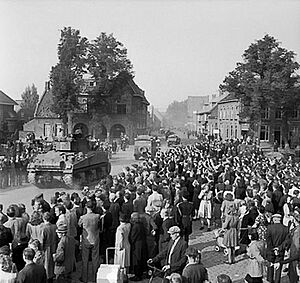
After the Allied landings in Normandy in June 1944, the Allies quickly moved towards the Dutch border. September 5 is known as Dolle dinsdag ("Mad Tuesday"). This is because the Dutch started celebrating, thinking they would soon be free. In September, the Allies launched Operation Market Garden. This was an attempt to cross rivers into the northern Netherlands and Germany. But they failed to capture the Rhine bridge at the Battle of Arnhem. However, large parts of the south were freed, including Nijmegen and Eindhoven.
Parts of the southern Netherlands were still not free. In the east of North Brabant and Limburg, British and American forces fought German troops. They cleared German positions between September and December 1944. The only tank battle ever fought on Dutch soil happened at Overloon.
At the same time, the Allies moved into Zeeland province. In October 1944, the Germans still held Walcheren island. This meant they controlled the Scheldt river, which led to the port of Antwerp. The Allies needed this port badly. So, the Battle of the Scheldt began. Canadian forces fought to clear the waterways.
By October 31, German resistance south of the Scheldt collapsed. Allied divisions attacked Walcheren Island. German defenses were strong. So, the Allies bombed the dikes of Walcheren to flood the island. They warned residents with leaflets, but 180 people died. The coastal guns on Walcheren were silenced in early November. The Scheldt battle was over.
After the Scheldt offensive, Operation Pheasant was launched to free North Brabant. British forces freed cities like Tilburg and 's-Hertogenbosch. Canadian and Polish forces also freed cities like Breda without civilian deaths.
The Dutch government had not wanted to flood the "Holland" region in 1940. This would have created an island out of the main cities. They felt too many people would die. However, Hitler ordered "Fortress Holland" to be held at all costs. Much of the northern Netherlands stayed under German control until March 1945.
The Hunger Winter
The winter of 1944–1945 was very harsh. It led to "hunger journeys" and many deaths from starvation (about 30,000), exhaustion, cold, and disease. This winter is known as the Hongerwinter ("hunger winter"). The Dutch government-in-exile called for a railway strike. In response, the Germans cut off all food and fuel to the western provinces. About 4.5 million people lived there. Severe hunger was common, and 18,000 people starved to death. Help finally came in early May 1945.
Bombing of Bezuidenhout
On March 3, 1945, the British Royal Air Force accidentally bombed the crowded Bezuidenhout neighborhood in The Hague. The British pilots meant to bomb the Haagse Bos forest, where Germans had V-2 rocket launchers. But the pilots had the wrong coordinates. Fog and clouds also blocked their view. So, the bombs fell on homes. The area was more crowded than usual with people who had left other parts of The Hague. 511 residents were killed, and about 30,000 lost their homes.
Liberation

After crossing the Rhine, Canadian, British, and Polish forces entered the Netherlands from the east. They freed the eastern and northern provinces. Important battles happened in Groningen and Otterlo in April 1945.
The western provinces were not freed until the German forces in the Netherlands surrendered. This happened on May 5, 1945, in Wageningen. Before this, the Swedish Red Cross was allowed to bring aid. Allied planes also dropped food over German-occupied areas.
On Texel island, nearly 800 men of the Georgian Legion, who fought for Germany, rebelled on April 5, 1945. Their rebellion was crushed by the German army after two weeks. Many Georgians, Texel residents, and Germans died. The Georgians who survived were sent back to the Soviet Union after the war.
After being freed, Dutch citizens started taking justice into their own hands. This also happened in other liberated countries.
War Deaths
By the end of the war, 205,901 Dutch people had died because of the war. The Netherlands had the highest death rate per person of all Nazi-occupied countries in Western Europe. Over half of these deaths (107,000) were Jewish people killed in the Holocaust. This number included many non-Dutch Jews who had come to the Netherlands seeking safety, like Anne Frank. Another 30,000 Dutch people died in the Dutch East Indies. They either died fighting the Japanese or in Japanese prison camps.
After the War
After the war, some people accused of working with the Germans were punished without a trial. Men who had fought with the Germans were used to clear minefields. Others were found guilty of treason by courts. Some people were wrongly arrested and later cleared, sometimes after being held for a long time.
The Dutch government first planned to take a large part of Germany. This plan was dropped. But two small German villages were added to the Netherlands in 1949 and returned in 1963. One plan that did happen was "Black Tulip." This was the removal of all German passport holders from the Netherlands. Thousands of Germans were deported.
The end of the war also meant the final loss of the Dutch East Indies. After Japan surrendered there, Indonesian nationalists fought a four-year war for independence against the Dutch. This eventually led to the Netherlands recognizing Indonesia's independence. Many Dutch and Indonesians then moved to the Netherlands.
World War II had many lasting effects on Dutch society. On May 4, the Dutch remember those who died during the war and all wars since. Many people still feel the emotional effects of the war, even generations later.
In 2017, the Dutch Red Cross apologized for not doing enough to protect Jewish, Sinti, Roma, and political prisoners during the war.
See also
- Netherlands in World War I
- Dutch resistance
- Liberation Day (Netherlands)


